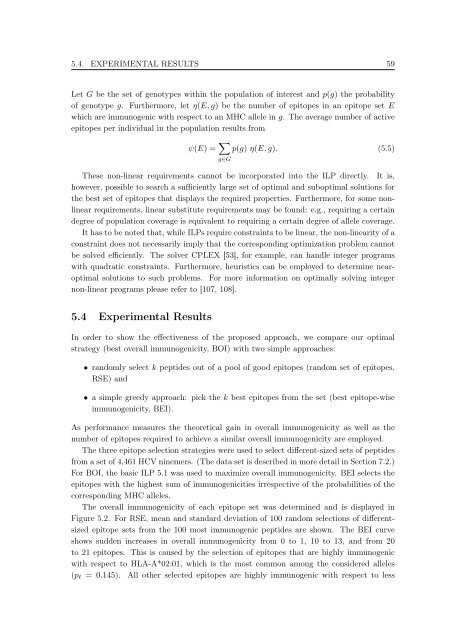New Approaches to in silico Design of Epitope-Based Vaccines
New Approaches to in silico Design of Epitope-Based Vaccines
New Approaches to in silico Design of Epitope-Based Vaccines
You also want an ePaper? Increase the reach of your titles
YUMPU automatically turns print PDFs into web optimized ePapers that Google loves.
5.4. EXPERIMENTAL RESULTS 59<br />
Let G be the set <strong>of</strong> genotypes with<strong>in</strong> the population <strong>of</strong> <strong>in</strong>terest and p(g) the probability<br />
<strong>of</strong> genotype g. Furthermore, let η(E, g) be the number <strong>of</strong> epi<strong>to</strong>pes <strong>in</strong> an epi<strong>to</strong>pe set E<br />
which are immunogenic with respect <strong>to</strong> an MHC allele <strong>in</strong> g. The average number <strong>of</strong> active<br />
epi<strong>to</strong>pes per <strong>in</strong>dividual <strong>in</strong> the population results from<br />
ψ(E) = <br />
p(g) η(E, g). (5.5)<br />
g∈G<br />
These non-l<strong>in</strong>ear requirements cannot be <strong>in</strong>corporated <strong>in</strong><strong>to</strong> the ILP directly. It is,<br />
however, possible <strong>to</strong> search a sufficiently large set <strong>of</strong> optimal and suboptimal solutions for<br />
the best set <strong>of</strong> epi<strong>to</strong>pes that displays the required properties. Furthermore, for some nonl<strong>in</strong>ear<br />
requirements, l<strong>in</strong>ear substitute requirements may be found: e.g., requir<strong>in</strong>g a certa<strong>in</strong><br />
degree <strong>of</strong> population coverage is equivalent <strong>to</strong> requir<strong>in</strong>g a certa<strong>in</strong> degree <strong>of</strong> allele coverage.<br />
It has <strong>to</strong> be noted that, while ILPs require constra<strong>in</strong>ts <strong>to</strong> be l<strong>in</strong>ear, the non-l<strong>in</strong>earity <strong>of</strong> a<br />
constra<strong>in</strong>t does not necessarily imply that the correspond<strong>in</strong>g optimization problem cannot<br />
be solved efficiently. The solver CPLEX [53], for example, can handle <strong>in</strong>teger programs<br />
with quadratic constra<strong>in</strong>ts. Furthermore, heuristics can be employed <strong>to</strong> determ<strong>in</strong>e nearoptimal<br />
solutions <strong>to</strong> such problems. For more <strong>in</strong>formation on optimally solv<strong>in</strong>g <strong>in</strong>teger<br />
non-l<strong>in</strong>ear programs please refer <strong>to</strong> [107, 108].<br />
5.4 Experimental Results<br />
In order <strong>to</strong> show the effectiveness <strong>of</strong> the proposed approach, we compare our optimal<br />
strategy (best overall immunogenicity, BOI) with two simple approaches:<br />
• randomly select k peptides out <strong>of</strong> a pool <strong>of</strong> good epi<strong>to</strong>pes (random set <strong>of</strong> epi<strong>to</strong>pes,<br />
RSE) and<br />
• a simple greedy approach: pick the k best epi<strong>to</strong>pes from the set (best epi<strong>to</strong>pe-wise<br />
immunogenicity, BEI).<br />
As performance measures the theoretical ga<strong>in</strong> <strong>in</strong> overall immunogenicity as well as the<br />
number <strong>of</strong> epi<strong>to</strong>pes required <strong>to</strong> achieve a similar overall immunogenicity are employed.<br />
The three epi<strong>to</strong>pe selection strategies were used <strong>to</strong> select different-sized sets <strong>of</strong> peptides<br />
from a set <strong>of</strong> 4,461 HCV n<strong>in</strong>emers. (The data set is described <strong>in</strong> more detail <strong>in</strong> Section 7.2.)<br />
For BOI, the basic ILP 5.1 was used <strong>to</strong> maximize overall immunogenicity. BEI selects the<br />
epi<strong>to</strong>pes with the highest sum <strong>of</strong> immunogenicities irrespective <strong>of</strong> the probabilities <strong>of</strong> the<br />
correspond<strong>in</strong>g MHC alleles.<br />
The overall immunogenicity <strong>of</strong> each epi<strong>to</strong>pe set was determ<strong>in</strong>ed and is displayed <strong>in</strong><br />
Figure 5.2. For RSE, mean and standard deviation <strong>of</strong> 100 random selections <strong>of</strong> differentsized<br />
epi<strong>to</strong>pe sets from the 100 most immunogenic peptides are shown. The BEI curve<br />
shows sudden <strong>in</strong>creases <strong>in</strong> overall immunogenicity from 0 <strong>to</strong> 1, 10 <strong>to</strong> 13, and from 20<br />
<strong>to</strong> 21 epi<strong>to</strong>pes. This is caused by the selection <strong>of</strong> epi<strong>to</strong>pes that are highly immunogenic<br />
with respect <strong>to</strong> HLA-A*02:01, which is the most common among the considered alleles<br />
(pℓ = 0.145). All other selected epi<strong>to</strong>pes are highly immunogenic with respect <strong>to</strong> less

















